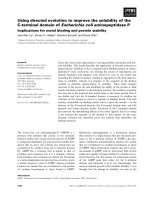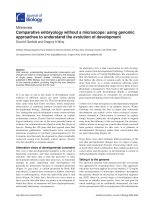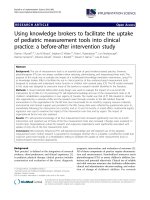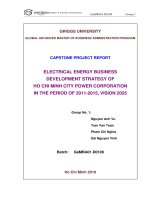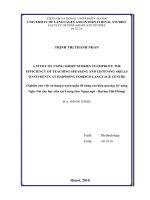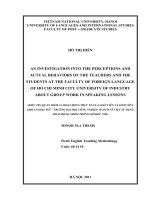Using big data to construct the Residential Property Price Index in Vietnam: The case of Ho Chi Minh City
Bạn đang xem bản rút gọn của tài liệu. Xem và tải ngay bản đầy đủ của tài liệu tại đây (2 MB, 52 trang )
VIETNAM NATIONAL UNIVERSITY, HANOI
VIETNAM JAPAN UNIVERSITY
NGUYEN THE HUNG
USING BIG DATA TO CONSTRUCT THE
RESIDENTIAL PROPERTY PRICE INDEX IN
VIETNAM:
THE CASE OF HO CHI MINH CITY
MAJOR: PUBLIC POLICY
CODE: …………………
RESEARCH SUPERVISORS:
Dr. Vu Hoang Linh
Hanoi, 2019
TABLE OF CONTENTS
DECLARATION ............................................................................................................... iii
ACKNOWLEDGEMENTS ................................................................................................iv
ABSTRACT .........................................................................................................................v
LIST OF ABBREVIATIONS .............................................................................................vi
LIST OF AND FIGURES AND TABLE ........................................................................ viii
CHAPTER 1
INTRODUCTION ....................................................................................1
1.1.
Background of the study ........................................................................................1
1.2.
Rationale of the study .............................................................................................2
1.3.
Aims and objectives of the study ...........................................................................6
1.4.
Research instrument ...............................................................................................6
1.5.
Structure of the study .............................................................................................7
CHAPTER 2
2.1.
LITERATURE REVIEW .........................................................................8
1. The Handbook on Residential Property Price Index ..........................................8
2.1.1.
Median/mean transactions price ......................................................................8
2.1.2.
Stratification or Mix adjustment ......................................................................9
2.1.3.
Repeat-sales ...................................................................................................10
2.1.4.
Hedonic method .............................................................................................10
2.2.
The previous residential property price indexes ..................................................12
2.2.1.
RPPI of Ireland ..............................................................................................12
i
2.2.2.
RPPI of Austria ..............................................................................................13
2.2.3.
RPPI of Malta ................................................................................................ 14
2.2.4.
RPPI of Thailand ...........................................................................................15
2.2.5.
RPPI of Indonesia ..........................................................................................16
2.2.6.
RPPI of Savills Vietnam ................................................................................17
CHAPTER 3
DEVELOPING RPPI IN VIETNAM, THE CASE OF HO CHI MINH
CITY
19
3.1.
The overview of real estate transaction in Vietnam .............................................19
3.2.
The data sources on real estate price in Vietnam .................................................20
3.3.
Building big data for RPPI calculating ................................................................ 22
3.4.
Calculating RPPI for apartment in Ho Chi Minh City .........................................26
CHAPTER 4
FINDINGS AND DISCUSSIONS .........................................................34
CHAPTER 5
POLICY IMPLICATION AND FURTHER STUDY ............................36
5.1.
Policy implication.................................................................................................36
5.2.
Further study.........................................................................................................38
CHAPTER 6
REFERENCES .......................................................................................40
ii
DECLARATION
I certify that I myself write this thesis entitled “Using big data to construct the
residential property price index in Vietnam: The case of Ho Chi Minh City”. It is not a
plagiarism or made by others. Anything related to others‟ works is written in quotation,
the sources of which are listed on the list of references. If then the pronouncement proves
wrong, I am ready to accept any academic punishment, including the withdrawal or
cancellation of my academic degree.
Signature
iii
ACKNOWLEDGEMENTS
No one can achieve anything without the help of others. This thesis could not be
completed without priceless assistances of many people. I would like to express
my gratitude to all of them.
Firstly of all, I would like to express my deepest thanks of gratitude to my
respectable supervisor, Dr. Vu Hoang Linh for his friendly and sympathetic
assistance and dedicated involvement throughout the process of this thesis. With
profound knowledge and experience, he helped me improving my research.
Without his instructions, the thesis would be undone.
Secondly, I would also like to be grateful to all my dear professors, JICA experts in
Vietnam Japan University who conveyed to me numerous courses and knowledge
and classmates of the Master of Public Policy, for their helpful as well as practical
suggestions. I will keep in mind all the memories that we had during my time at
Vietnam Japan University.
Last but not least, I also own a great debt of gratitude to my family and friends for
their immeasurable support bot all my degree and in this arduous process of this
study.
iv
ABSTRACT
Calculating real estate price index is one of the major challenges for statistical
agencies around the world. However, the need for tools to monitor the real estate
market is essential from all levels from micro to macro management. Therefore,
statistical agencies of some countries in the world and some real estate companies
like Savill Vietnam have built their own methods based on their actual conditions
to calculate this index. Thus, it might be impossible to compare the results.
Recently, international statistical organizations have jointly published a manual to
guide the general methodology for calculating this indicator.
In addition, the development of information technology has also brought many
new tools to serve economic management including big data sources.
This study attempts to develop the residential property price index (RPPI) in
Vietnam with specific in the apartment market in Ho Chi Minh City using big data
from property advertisement web portals as a prototype. The hedonic regression
method is used to calculate this index.
The research results show that the calculation residential property price index from
big data source is completely feasible and that is suggestions for using big data to
calculate other statistical indicators.
Keywords: Big data, Hedonic Regressions, Ho Chi Minh City apartment,
Residential Property Price Index, web crawler.
v
LIST OF ABBREVIATIONS
ABS: Australian Bureau of Statistics
API: Application Programming Interface
BDP: Big data processing
BI: Bank of Indonesia
CSO: Central Statistics Office of Ireland
Eurostat: The statistical office of the European Union
GDP: Gross Domestic Product
GRDP: Gross Regional Domestic Product
GSO: The General Statistics Office of Vietnam
HoREA: Ho Chi Minh Real Estate Association
ILO: International Labor Organization
IMF: International Monetary Fund
MAD: Median absolute deviation
MPD: Mobile position data
NER: Named Entity Recognition
OECD: The Organisation for Economic Co-operation and Development
RPPI: Residential Property Price Index
vi
RFID: Radio Frequency Identification
SDGs: Sustainable Development Goals
SBV: State Bank of Vietnam
UNECE: The United Nations Economic Commission for Europe
WB: The World Bank.
vii
LIST OF AND FIGURES AND TABLE
List of figures
Figure 1.1 Five characteristics of Big data ..........................................................................4
Figure 3.1 The house selling/ buying flow in Vietnam .....................................................19
Figure 3.2 The Flow of building database .........................................................................24
Figure 3.3 Map of apartments advertised in Ho Chi Minh city .........................................25
Figure 3.4 Extract data fields from advertisements ...........................................................26
Figure 3.5 Distribution of Price .........................................................................................29
Figure 3.6 RPPI_aparment of Hochiminh City with Jan, 2018 is reference .....................33
List of Tables
Table 3.1 Summary statistics of database ..........................................................................28
Table 3.2 Dummy Hedonic Regression result ...................................................................30
Table 3.3 RPPI_apartment in Ho Chi Minh city with Mar,2018 is reference ...................32
Table 3.4 RPPI_apartment in Ho Chi Minh city with Jan,2018 is reference ....................32
viii
ix
CHAPTER 1
1.1.
INTRODUCTION
Background of the study
Fluctuations in housing prices have important impacts on substantial economy.
In the period 2007-2009, the bubble of real esates in Vietnam led to
marcoeconomic instability likes high inflation, trade deflicit and affected
economic growth. More seriously, there has been a considerably increase in
housing price and its reversal in the United States which resulted during the
global financial crisis.
As an asset price in the measurement of inflation, property price becomes an
important leading indicator of economy‟s dynamic since investment in a
property sector is a long-term type of investment. Property statistics could
provide an early sign of economic cycle movement. Rising of property prices
often leads to an expansionary phase period (boom) whereas falling of property
prices indicate a contractionary phase (bust) (Eurostat, 2013).
The requirement for suitable indexes enabling one to record changes in real
estate prices with precision was extremely crucial in such good conditions. Not
only does this assist policy makers but also market participants seeking the time
when housing prices hit either bottom or top.
Thus, it is necessary to develop housing price indexes that can adequately
capture housing market trends.
The development of such indexes, however, is not an easy task due to the fact
that residential properties are heterogeneous in terms of their structural
characteristics such as location, size, and facilities. Each of the house consisting
of the location, maintenance and the appliances has different and distinguished
characteristics in various degrees, so there are no two houses that are identical in
1
terms of quality. Even if the location and basic structure maintain an
equivalence at two periods of time, ages or quality of the buildings and the
houses are not the same through out the time due to renovations and
depreciation of the structure. Furthermore, houses are infrequently sold,
meaning that the limited frequency of transaction data available so that it is very
difficult to apply the “like with like” method to house pricing as the method of
other price index as consumer price index or producer price index.
Consequently, the development of the housing price indexes was one of the
most difficult tasks for national statistical agencies in terms of methodology.
However, as nations need indicators to help reflect the real estate continuance in
macro management of economy, they go on constructing various methods in
order to calculate the property prices indexes based on their actual context.
Thus, it might be impossible to compare the results.
1.2.
Rationale of the study
Recently, many researchers and international statististical agencies have
developed the methods of compiling appropriate residential real estate price
indexes. The Handbook on Residential Property Price Index, co-ordinated by
Eurostat, ILO (International Labor Organization), IMF (International Monetary
Fund), OECD (the Organization for Economic Co-operation and Development),
UNECE (The United Nations Economic Commission for Europe ), WB (the
World Bank) was published. This coordination produced the very first
multidimension abstract of the conceptual and practical issues, which is related
to the collection of residential and real estate property price indexes. Moreover,
this book also offers guides on the collection of house price indexes and helps
increase international comparative study on residential property price indexes as
well. Based on this document, each country develop its own way to calculate the
index which are pretty adaptable with the practical situation.
2
In Vietnam, the real estate is crucial for the economic growth with more than 14
trillion US dollar turnover per year (Dragon Capital, 2017), but up to now, the
real estate indicator system reflecting on its position in the picture of the whole
economy including price index is very poor. Until the present, related to the real
estate price indicator, only the real estate service provider named Savill is
publishing the housing price index, whose methodology and data sources are
unclear for the public. Thus, it is major utilised in Savill‟s business purpose
without the other researchers or policy makers.
Consequently, system of appropriate indexes for real estate is necessary for policy
makers, analysts, and financial instituttions to have deeper knowledge on the real
estate market and financial market as well as to monitor impacts on Vietnamese
economy and the health of the financial market.
In recent time, information technology has grown very quickly and has created an
extra-large amount of digital data known as “Big Data” – “a term that describes
the large volume of data- both structured and unstructured - that inundates a
business on a day-to-day basis” (the SAS, Inc).
It is simple that big data is more abundant and complicated data compared to the
basic data such as survey data. Especially, new data sources might originate
from the Internet, the satellite, post in the social network, etc. This kind of data
could be from the different forms such as images, sounds. These packs of data
are so extremely resilient that basic data software cannot analyze them.
However, these data can be used to solve all sources of your problems that you
were not able to get rid of before. Big data has five important characteristics
known as 5Vs as the figure:
3
Figure 1.1 Five characteristics of Big data
(Source: Yuri Demchenko)
As can be seen from the figure above, there are 5Vs of Big Data including
Volume, Velocity, Value, Veracity, and Variety.
The first is that Volume is defined as the large sources of data generated every
millisecond. It could be all the emails, messages, pictures, clips, memes, etc.,
comprised. With big data scientist, these data will be stored and widely used
with the help of the distributed systems in different locations.
4
In term of Velocity, this phenomenon means how fast the new data generated
and spread around. For example, online messages, which spread viral instantly,
or the captured photos by the satellite, transferred the data processing software.
Therefore, big data technology allows scientists to simultaneously analyze the
data while it continue generating without putting it into the databases.
Next, Variety refers to the divergent kinds of data, which have been used. In the
past, basic data are said to focus on how to fit into the assumptions, figures,
tables or relational databases, such as financial data. With big data technology,
there will be multiple types of data (structured and unstructured) including
messages, social media conversations, photos, sensor data, video or voice
recordings.
The following term is Veracity identified as the trustworthiness of the data.
Many forms of big data like posts on Twitter, Facebook, Instagram, etc.,
consisting of false information, distorted news which might be unreliable,
inaccurate, and less controllable. However, the analytical software for big data is
able to help users to cope with these data. Hence, a large database often create
the issues of lacking quality or accuracy. Finally, it can be believed that Value is
one of the most noticeable Vs in this figure. Importantly, businesses make a
business decisions in any attempt to gather and process their databases. Clearly,
it is possible for the users to be trapped into the buzz trap if they start using big
data without a clear analysis of cost and benefit.
Besides requiring new data processing and management methods, big data offers
several benefits to a number of users such as the government bodies, enterprises,
researchers in their fields.
It is more necessary for statistics, academic institutions if they can create new
measurement, bridging the lagging time of existing statistics and provide an
advanced source of data to produce official statistics. Those advantages and
5
disadvantages of big data prompted statistical institution to be more careful when
implementing big data as new source of official statistics. As mentioned by
Hammer et al. (2017) “Big Data offers opportunities, challenges, and implications
for official statistics that compilers and users of statistics need to be aware of
when they start to incorporate big data into their work plan to the extent relevant.”
1.3.
Aims and objectives of the study
The overarching goal of this research is to calculate the residential property
price index in Ho Chi Minh City especially for apartment sector from big data
source.
For the achievement of the overall aims, this research seeks out for the following
specific objectives:
(1) Buiding a tool to crawl real estate advertisments from the Internet.
(2) Extracting information from advertisments to build up real estate database.
(3) Calculating the residential property price index in Ho Chi Minh City for
apartment sector.
1.4.
Research instrument
A quantitative research was employed in this study to measure real estate price
index in Ho Chi Minh City (HCM).
To collect and build up effective and relevant data for this study, four research
techniques were carried out:
(i) Building the web- crawler tool to collect advertisment from internet.
(ii) Using the Named Entity Recognition (NER) and Vietnamese address
normalization to normalize information.
(iii) The Big data processing (BDP) to extract information from the real
estate advertisements.
6
1.5.
Structure of the study
The study comprised of three parts: Introduction, Development and the
Conclusion with five chapters.
Chapter 1: Introduction presents the background, rationale, aims and
objectives, methods, and design of the study
Chapter 2: Literature Review is intended to give some theoretical background
related to calculate residential property price index.
Chapter 3: Developing RPPI in Vietnam: a case of Ho Chi Minh City deals
with research governing orientation, research methods and presents the situation
analysis, data collection instruments, data collection procedures and calculate
RPPI. The detailed results of the database and a comprehensive analysis on the
data collected are focused.
Chapter 4: Findings and Discussions shows major findings and discussions for
residential housing price index in HCM.
Chapter 5: Conclusion and Implications summarizes the issues addressed,
recapitulates the research procedure, and further makes recommendations for the
act of using Big Data in producing indicator and measurements in the following
research.
7
CHAPTER 2
LITERATURE REVIEW
Like any other price indexes, house price index measures changes in the average
price of properties reflecting changes in the quality-mix of properties transacted
over two periods of time. There are many areas of society where individuals or
organizations use residential property price indices (RPPIs) directly or indirectly
either to influence practical decision making or to inform the formulation and
conduct of economic policy, (OECD, 2013), so that this kind of index have a
number of important uses.
Before 2013, international statistical institutes like IMF, UNSD, ect have not just
publiced the muanual as the international guide-line for this index, so that each
country has different methods depending on their actual context, and it might be
impossible to compare the results. After the Handbook on Residential Property
Price Index was publiced in 2013 by Eurostat and some major international
statistics organizations , some countries have developed their index base on this
guide lines.
2.1.
1. The Handbook on Residential Property Price Index
This handbook is the first comprehensive overview of conceptual and practical
issues related to the compilation of price indexes for residential properties and
also provide international guidance on the compilation of house price indexes and
to increase international comparability of residential property price indexes.
According to this documents, there are four methods can be applied to calculate
this index.
2.1.1. Median/mean transactions price
Using the indicators of the main inclination from the distribution of housing
price for purchased houses during the period is one of the easiest way to
8
calculate house prices. As residential property price distributions are often
mingled (mainly representing the repercussion of the varied and mixed traits of
houses, the correlation in income distributions and the zero lower is positive,
bounding on transaction prices), this is more preferable to use the median than
the mean. In addition, because there is no need for data on housing traits, but
only the house‟s size or location of the house to measure median or mean, a
number of prices can be applied.
However, the inevitable obstacle of this method is that it is bounded by the
buckle
of „compositional‟ factors. The compositional factors contain the
amount of the sales of real estate within specific price level. If there is any report
about the selling of low-value properties in the area in a monnth, and few of the
higher-value properties in that area, this created an implication that there has
been a decline in the median or average. Nevertheless, most sales of the
following month in that area may be in superior properties (i.e., higher values);
then this case may imply that the median and average price experienced an
increase even the actual overall values may have dropped. Compositional
change and seasonality may be counted as influential factors on median prices.
Therefore, it is not likely that the samples of observed transactions can be
judged as random. Although the median prices are widely used, many other
methods are being used in multiple countries to tackle the problem of
compositional changes and gain better measures of housing prices.
2.1.2. Stratification or Mix adjustment
By the application stratification to establish a mix-adjusted measure of house
prices is one of the effective means to control the modifications of the sold mixproperties. It is reported that this method is widely exerted by the Australian
Bureau of Statistics (ABS) to support the caculation of their house prices.
Measures with compiling adjustment have been stated to be used in different
9
countries like Canada, Germany and the United Kingdom. It should be notified
that there are variations in the approaches applied in specific condition of each
country because of the diversity in characteristics of housing markets in
different areas. Using this method, some small regions (e.g., suburbs) are
accumulated into bigger regions and then they compared average of price
changes in these bigger regions. Another method is to use the stratificatio of
price on the basis of the compositional change between lower- and higher-priced
suburbs. It is obvious that this method can prove
highly effectiveness in
minimizing the impacts of compositional change. For instance, at any time , sold
real estate can be classified into groups (or strata) , according to the long run
median price of their respective suburbs. The mix-adjustment measure of the
city-wide price average changes, then calculated as the average changes in the
medians for each group.
2.1.3. Repeat-sales
Instead of taking each transaction‟s price level as a focus, this method
depends on the modifications of the price of real estate properities, which are
sold more than once. It aims to figure out the same component in the price
modification, over a specific period of time. However, a hindrance of this
repeating sales method is
that it is only able with the figures from the
transactions which involve real estate with a record of the previous sales.
Another limitation is that estimating price modications in aspecific period of
time, a quarter, it will continue to be rennovated , based on ther sales, occurred
in subsequent quarters.
2.1.4. Hedonic method
In order to repeat the sales method, hedonic regression model will also been
used by researchers, and some countries like United Kingdom and United States,
which have applied this method as one of the official measures. The hedonic
10
approach defines properties as some bundle of characteristics such as the pricedetermining ones (house‟s size, bedrooms, location, etc). And the key idea in
which they are “bounded” is that the characteristics are separated and no price in
the market for each characteristic, only the characteristic for the house, structure
and land, as a whole. Therefore, a hedonic method can take account of changes
in the composition of transactions in each period. In principle, it can also control
quality improvements, although the possiblility and feasibility of the method lie
on the sufficience and availibility of data on characteristics of residential
properties.
This handbook also provides three hedonic approaches: (i) the hedonic time
dummy approach, (ii) characteristics approach, and (iii) imputation approach.
This follows previous literature in this area including Triplett (2006), Diewert,
W.E., S. Heravi and M. Silver (2009) and Hill (2010). A problem is that there are
many subtitute apparatus for each approach, depending on the estimated period
of hedonic coefficients, characteristics, and weights are held constantly; whether
double or single imputation will be used for either prices or weights; a direct of
indirect formation will be used; chained, rolling window or fixed baskets of
characterics, and more.
Each method requires each data source and has both advantages and drawbacks;
therefore, countries rely on their real situation to chose the most reasonable
approaches. According to the Bank of International Settlement, 41/58 countries
in the world use Hedonic method to calculate their RPPIs with data contain
characteristics of residential property.
11
2.2.
The previous residential property price indexes
2.2.1. RPPI of Ireland
In Ireland, from 2016, the Central Statistics Office of Ireland (CSO) has
launched the new Residential Property Price Index. The new RPPI is based on
Stamp Duty data supplied by the Revenue Commissioners, covering all
residential property transactions in the State. CSO uses hedonic method for the
measurement
of
transactions
over
change of residential property price. In
two
this method,
or more successive periods are pooled and the
characteristics which influence price
(dwelling type, dwelling size,
geographical location and neighbourhood deprivation/affluence) are analysed
and their relative contributions to the overall price are estimated. By excluding
the price change determined by these characteristics independently, CSO are left
with a pure price change for a consistent set of characteristics from one time
period to another - or more simply - a residential property price index. The new
RPPI replaces the existing mortgage-based RPPI launched in 2011. The new
RPPI is statistically more robust than the existing RPPI and provides for a more
detailed geographical breakdown of house price indices. The new index is
accompanied by a comprehensive range of additional indicators on the
residential property market.
The hedonic method used for the RPPI uses a log-linear functional form.
The equation is as follows:
ln
(𝑝𝑖𝑡 ) = 𝑥𝑖𝑡 𝛽 + 𝛿𝑡 𝐷𝑡 + 𝜇𝑖𝑡
where:
𝑝𝑖𝑡 is the price of dwelling i in period t
12
𝑥𝑖𝑡 is a vector of explanatory variablesof dwelling i in period t: Total floor
area (m2), Dwelling type (semi-detached/ detached/ terraced), Eircode routing key and
Deprivation Index.
𝛽 is a vector of explanatory price coefficients
𝛿𝑡 is a vector of time period coefficients
𝐷𝑡 is a „time dummy‟ (value=1 if in time period t, otherwise 0)
𝜇𝑖𝑡 is an error term
When the regression is applied to a pool of data covering multiple time
periods, the time coefficient 𝛿𝑡 can be derived for each period (except the
reference period, typically the first period, where 𝛿1 = 1).
For any two successive time periods, t-1 and t, the antilog of 𝛿𝑡 divided by
the antilog of 𝛿𝑡−1 provides an estimate of the aggregate quality-adjusted house
price change that has occurred (i.e. the change in house prices after changes in
the various known explanatory variables have been accounted for).
Thus the index for period t is given by:
𝐼𝑡 =
𝑒𝜕𝑡
𝑒 𝜕 𝑡−1
× 𝐼𝑡−1
Where:
𝐼𝑡 is the index in period t
𝐼𝑡−1 is the index in period t-1
2.2.2. RPPI of Austria
In Austria, they use big data as the data source for RPPI also. The RPPI
relies on quotation prices or asking price, which includes the evaluation of
prices, combined with “structural” (specific-price). After the evaluation, about
10,000 samples are available each year. In the advertisements, they extract the
13
data to calculate RPPI for single family house and Condominiums for Vienna
and whole country. The “Location” (specific-address) variables are used to
modify the spatial differences of the concencus level. The calculation used a
hedonic regression model with a fixed structure over time. This approach may
produce biased estimates if the effects of the variables change over time. The
RPPI for Austria excluding Vienna was composed of the index for
condominiums and the index for single-family houses at a ratio of 70% to 30%,
with the aggregated index for condominiums comprising the index for new
condominiums and that for used condominiums at a ratio of 12.7% to 87.3%.
2.2.3. RPPI of Malta
In Malta, they collect advertisements for the sale of properties in
newpapers. The property include flats, maisonettes, both in shell and in finished
form, together with terraced houses, townhouses, house of character and villas.
They also use Hedonic regression for calculating this index.
From the aforementioned classification, the author had insisted that the
method is mostly deemed as the first priority methodology to measure the
changes of the real estate price. By this method, a number of house‟s traits,
which affected the prices were analyzed. For instance, the impact on the housing
price can be calculated and monitored. This would allow the calculation of the
author‟s preffered index for a price modification to get a constant pack of
housing characteristics, in other words, a land property price index.To apply this
method, the data must consist of sufficient statistic of housing traits and
observations.
14
2.2.4. RPPI of Thailand
In Thailand, they publish monthly this index with the volume of house
price indices, consisted of 4 measurements as follows: private house with land,
with land, apartment, and land.
The dataset for compiling RPPI comes from the structured big data source
of Commercial Bank Mortgage Loan.
The indices were collected and measured from 17 most common
commercial bank‟s mortgage loan in Bangkok and proximate area (Bangkok,
Samut Prakan, Nonthaburi, Pathum Thani, Nakhon Pathom and Samut Sakhon).
Single detached house with land, town house with land and condominium price
indices were compiled by using Rolling window and time dummy hedonic
regressions method (3-month moving average), controlling 4 housing
characteristics (age, storey, entrepreneur and distance to metropolitan
transportation services such as the sky train, the underground and express way).
6
ln 𝑃𝑡 = ln
(𝑃0) +
12
𝛽𝑘 𝑋𝑘 +
𝑘=1
𝛼𝑗 𝑇𝐷𝑗
𝑗 =2
Where:
Pt = price per square meter;
P0 = Base price;
Xk = residential characteristics:
- the distance of the center of the district to the nearest Bangkok Mass
Transit System and Metropolitan Rapid Transit;
- The distance of the center of the district to the nearest motorway;
- The distance of the center of the district to the nearest Chao Praya
express boat;
15

